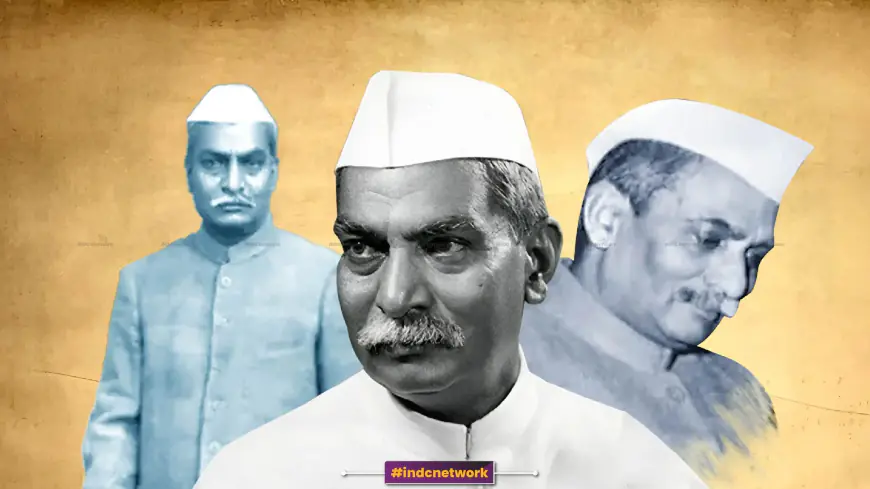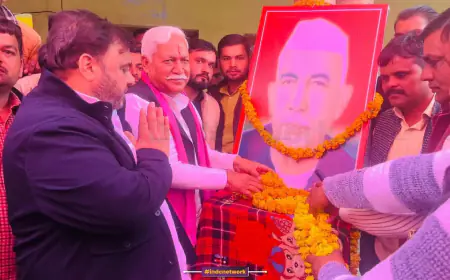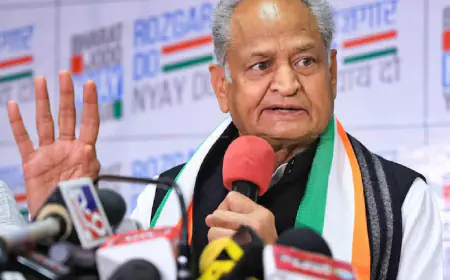Dr. Rajendra Prasad: The First President of India (1950-1962) – Legacy, Leadership & Nation-Building
Dr. Rajendra Prasad, India's first President, served two consecutive terms from 1950 to 1962. A freedom fighter, scholar, and statesman, he played a crucial role in shaping the newly independent nation's democratic and political foundations. From his early life as a lawyer to his deep involvement in India's struggle for freedom under Mahatma Gandhi, Prasad's leadership was defined by humility, patriotism, and a strong commitment to democratic values. As President, he oversaw significant changes, including the drafting of the Indian Constitution and the nation’s early post-independence challenges. His legacy continues to inspire Indian democracy today.

INDC Network : Biography : Dr. Rajendra Prasad: The First President of India (1950-1962) – Legacy, Leadership & Nation-Building
Biography of Dr. Rajendra Prasad (1950–1962)
Early Life and Education : Dr. Rajendra Prasad was born on December 3, 1884, in Zeradei, a small village in the Siwan district of Bihar, India. He was born into a devout Hindu family, and his upbringing was deeply influenced by the values of service, humility, and dedication to society. His father, Mahadev Sahai, was a scholar of Persian and Sanskrit, and his mother, Kamleshwari Devi, was a pious woman, deeply immersed in religious duties.
From an early age, Rajendra Prasad exhibited exceptional intellectual capabilities. He was admitted to the Chapra District School at the age of five, and his academic excellence was apparent from the beginning. After his primary education, he went on to attend the prestigious Presidency College in Calcutta (now Kolkata), where he earned a degree in law. His academic journey did not end there, as he continued to pursue higher education, eventually obtaining a master's degree in law and later a Doctorate of Law.
Early Career and Involvement in the Independence Movement
Dr. Rajendra Prasad initially embarked on a legal career, practicing law at the Calcutta High Court and later at the Patna High Court. Despite his growing success as a lawyer, his heart lay in the fight for India’s freedom from British rule. It was during his time in Calcutta that Prasad first encountered the ideas of Mahatma Gandhi. Gandhi’s call for non-violent resistance against British colonialism deeply resonated with Prasad, who was soon drawn into the fold of the Indian National Congress and the larger independence movement.
His involvement with the freedom struggle was gradual but impactful. In 1917, Prasad joined Gandhi in the Champaran Satyagraha, a movement aimed at securing rights for poor indigo farmers in Bihar who were being oppressed by British planters. Prasad’s leadership and organizational skills were evident during this campaign, which marked a turning point in his life as he became a full-time freedom fighter. His close association with Gandhi shaped his political ideals, particularly his emphasis on simplicity, humility, and non-violence.
Leadership in the Indian National Congress
Prasad’s political journey within the Indian National Congress was marked by steady growth in influence and responsibility. In 1920, he took part in the Non-Cooperation Movement led by Gandhi, which called for boycotting British institutions and products. He also participated in the Salt March in 1930 and the Quit India Movement in 1942, both pivotal events in the independence struggle.
Throughout his political career, Rajendra Prasad held several important positions within the Congress party. He served as the President of the Indian National Congress multiple times, notably in 1934, 1939, and 1947. His leadership during these crucial periods of India’s freedom struggle was widely admired for its calmness, perseverance, and moral clarity. He was a key figure in negotiations with the British government, including the Simla Conference in 1945 and the Cabinet Mission in 1946, both of which were crucial steps leading to India's independence.
Role in the Constituent Assembly and Drafting of the Constitution
After India gained independence on August 15, 1947, Rajendra Prasad’s role became even more significant. He was elected the President of the Constituent Assembly of India, a body tasked with drafting the Constitution of India. His leadership in this position was pivotal, as he guided the assembly through long debates and discussions to craft a democratic Constitution for the newly independent nation.
As Chairman of the Constituent Assembly, Prasad played a crucial role in ensuring that the voices of all sections of Indian society were heard during the drafting process. He worked closely with Dr. B.R. Ambedkar, the chief architect of the Indian Constitution, and other key leaders like Jawaharlal Nehru, Sardar Vallabhbhai Patel, and Maulana Abul Kalam Azad to create a Constitution that would uphold the ideals of justice, equality, and liberty for all citizens.
On January 26, 1950, the Constitution of India came into force, and India officially became a republic. It was on this historic day that Dr. Rajendra Prasad was sworn in as the first President of India.
Presidency (1950–1962)
As India’s first President, Dr. Rajendra Prasad set the precedent for the role of the President in Indian democracy. His presidency spanned 12 years, from 1950 to 1962, during which time he served two full terms. His leadership during this critical period in India’s history was marked by a deep sense of duty, integrity, and respect for democratic values.
First Term (1950-1957)
During his first term as President, Rajendra Prasad worked closely with Prime Minister Jawaharlal Nehru and his cabinet. He was deeply involved in overseeing the implementation of the Constitution and in ensuring the smooth functioning of the new democratic institutions. Despite the ceremonial nature of the presidency, Prasad did not shy away from offering his opinions on matters of national importance. His views, though often conservative, were always rooted in the principles of fairness and justice.
One of the major challenges during his first term was integrating the princely states into the Indian Union. With the efforts of Sardar Vallabhbhai Patel and V.P. Menon, most princely states had been integrated into India by 1949. However, as President, Prasad played a crucial role in overseeing the legal and constitutional aspects of this process, ensuring that it was conducted peacefully and lawfully.
Another key achievement during his first term was his support for land reform policies. Although he had reservations about certain aspects of Nehru's socialist policies, Prasad was committed to reducing inequality and improving the living conditions of India’s rural population. His rural background and deep understanding of agricultural issues made him a strong advocate for farmers' rights.
Second Term (1957-1962)
In 1957, Rajendra Prasad was re-elected as President, becoming the only Indian President to have served two full terms. His second term was marked by further consolidation of India’s democratic institutions and the continuation of social and economic reforms.
One of the significant events during his second term was the reorganization of Indian states on linguistic lines in 1956. This was a contentious issue, but Prasad’s wise counsel helped navigate the complexities of the process, ensuring that the reorganization was carried out without disrupting the national unity.
In 1962, towards the end of his second term, India faced the Sino-Indian War, a conflict that exposed weaknesses in India’s military preparedness. Although this was a challenging time for the nation, Prasad’s leadership remained steadfast, and his calls for national unity during this crisis were widely respected.
Personal Values and Legacy
Dr. Rajendra Prasad is remembered for his simplicity, humility, and unwavering commitment to the nation. He was a man of few words but deep thought. Even as President, he led a simple life, often forgoing the luxuries that came with his office. He was deeply spiritual, and his faith in the principles of Mahatma Gandhi’s non-violent resistance and selfless service to the nation remained a guiding force throughout his life.
One of Prasad’s most notable contributions was his ability to bridge the gap between traditional Indian values and the modern democratic ideals of equality and justice. His conservative outlook was tempered by a pragmatic approach to governance, and he often sought to reconcile differences between various factions within the Congress party and the larger political landscape of post-independence India.
Retirement and Death
After completing his second term as President in 1962, Dr. Rajendra Prasad retired from public life. He returned to his ancestral village of Sadaqat Ashram near Patna, where he spent his remaining years in quiet reflection and writing. He authored several books during his retirement, including his autobiography, Atmakatha, and India Divided, which reflected his deep understanding of India’s political and social issues.
On February 28, 1963, Dr. Rajendra Prasad passed away at the age of 78. His death marked the end of an era in Indian politics, but his legacy as a freedom fighter, scholar, and statesman continues to inspire future generations of Indians.
Conclusion : Dr. Rajendra Prasad’s life and career epitomized the ideals of service, humility, and dedication to the nation. As India’s first President, he laid the foundations for the role of the President in a newly independent, democratic nation. His leadership during the crucial early years of India’s independence was instrumental in shaping the country’s political and constitutional framework. Today, Dr. Rajendra Prasad is remembered as a towering figure in Indian history, whose legacy of leadership and service continues to influence the trajectory of the nation’s democratic journey.
What's Your Reaction?












































































































































































